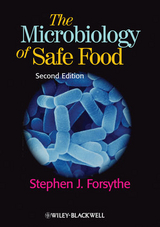
The Microbiology of Safe Food
Blackwell Science Ltd (Verlag)
978-0-632-05487-9 (ISBN)
- Titel erscheint in neuer Auflage
- Artikel merken
Throughout the world, food production has become more complex. Raw materials are often sourced globally, and the food is processed through an increasing variety of complex techniques. Food safety issues such as E. coli outbreaks and BSE are never far from the newspaper headlines, becoming grounds for increasing public concern. "The Microbiology of Safe Food" reviews the production of food and the level of microorganisms that humans ingest, covering both food pathogens and food spoilage organisms. The comprehensive contents include: the dominant foodborne microorganisms; the means of their detection; microbiological criteria and sampling plans; the setting of microbial limits for end-product testing; predictive microbiology; the role of HACCP; Microbiological Risk Assessment; the setting of Food Safety Objectives; and, relevant international regulations and legislation. Internet sources of information are listed and chapter up-dates are available on the World Wide Web.
Dr Stephen Forsythe has many years' experience of teaching food microbiology to university students and to professionals within the food industry and government regulatory bodies. He has written an extremely useful and important book that is not only a key text for all those studying food science, technology and food microbiology but a valuable resource for government and food company regulatory personnel, quality control officers, public health inspectors, environmental health officers, food scientists, technologists and microbiologists.
Preface. 1 Introduction to Safe Food. 1.1 What is Safe Food? 1.2 The manufacture of Hygienic food. 1.3 Functional foods. 2 Basic Aspects. 2.1 The microbial world. 2.2 Bacterial cell structure. 2.3 Microbial growth cycle. 2.4 Death kinetics. 2.5 Factors affecting microbial growth. 2.6 Preservatives. 2.7 Microbial response to stress. 2.8 Predictive modelling. 3 Foodborne Illness. 3.1 The size of the food poisoning problem. 3.2 Consumer pressure effect on food processing. 3.3 Testing foods for the presence of pathogens. 3.4 Control of food poisoning. 3.5 Surveillance programmes. 3.6 Causes of food poisoning. 3.7 The microbial flora of the human gastrointestinal tract. 3.8 The mode of action of bacterial toxins. 3.9 Virulence factors of foodborne pathogens. 4 The Microbial Flora of Food. 4.1 Spoilage microorganisms. 4.2 Shelf life indicators 4.3 Methods of prevention and shelf life extension. 4.4 Fermented foods. 4.5 Prebiotics, probiotocs and synbiotics. 4.6 Microbial biofilms. 5 Food Poisoning Microorganisms. 5.1 Indicator organisms. 5.2 Foodborne pathogens: bacteria. 5.3 Foodborne pathogens: viruses 5.4 Seafood and shellfish poisoning. 5.5 Foodborne pathogens: eucaryotes. 5.6 Mycotoxins. 5.7 Emerging and uncommon foodborne pathogens. 6 Methods of Detection. 6.1 Prologue. 6.2 Conventional methods. 6.3 Rapid methods. 6.4 Rapid end-detection methods. 6.5 Specific detection procedures. 6.6 Accrediation schemes. 7 Food Safety Management Tools. 7.1 Microbiological safety of food in world trade. 7.2 The management of hazards in food which is in international trade. 7.3 Hazard Analysis Critical Control Point (HACCP). 7.4 Outline of HACCP. 7.5 Microbiological criteria and HACCP. 7.6 Microbiological hazards and their control. 7.7 HAACP plans. 7.8 Sanitation Standard Operating Procedures (SSOPs) 7.9 Good Manufacturing Practice (GMP) and Good Hygiene Practice (GHP). 7.10 Quality Systems. 7.11 Total Quality Management (TQM). 7.12 ISO 9000 Series of standards. 8 Microbiological Criteria. 8.1 International Commission on Microbiological Specifications for Foods. 8.2 Codex Alimentarius principles for the establishment and application of microbiological criteria for foods. 8.3 Sampling plans. 8.4 Variable plans. 8.5 Attributes sampling plan. 8.6 Principles. 8.7 Microbiological limits. 8.8 Examples of sampling plans. 8.9 Implemented microbiological criteria. 8.10 Public Health (UK) Guidelines for Ready-To-Eat Foods. 9 Microbiological Assessment. 9.1 Risk assessment (RA). 9.2 Risk management. 9.3 Risk communication. 9.4 Food Safety Objectives. 9.5 Application of MRA. 10 Regulations and Authorities. 10.1 Regulations in international trade of food. 10.2 Codex Alimentarius Commission. 10.3 Sanitary and Phytosanitary measures (SPS), Technical Barriers to Trade (TBT) and the World Health Organisation (WHO). 10.4 Food authorities in the United States. 10.5 European Union legislation. 10.6 Food safety agencies. Glossary of Terms. Appendix: Food Safety Resources on the World Wide Web. References. Index.
| Erscheint lt. Verlag | 26.10.2000 |
|---|---|
| Zusatzinfo | 110 |
| Verlagsort | Oxford |
| Sprache | englisch |
| Maße | 156 x 234 mm |
| Gewicht | 637 g |
| Themenwelt | Naturwissenschaften ► Biologie ► Mikrobiologie / Immunologie |
| Technik ► Lebensmitteltechnologie | |
| ISBN-10 | 0-632-05487-5 / 0632054875 |
| ISBN-13 | 978-0-632-05487-9 / 9780632054879 |
| Zustand | Neuware |
| Haben Sie eine Frage zum Produkt? |
aus dem Bereich



